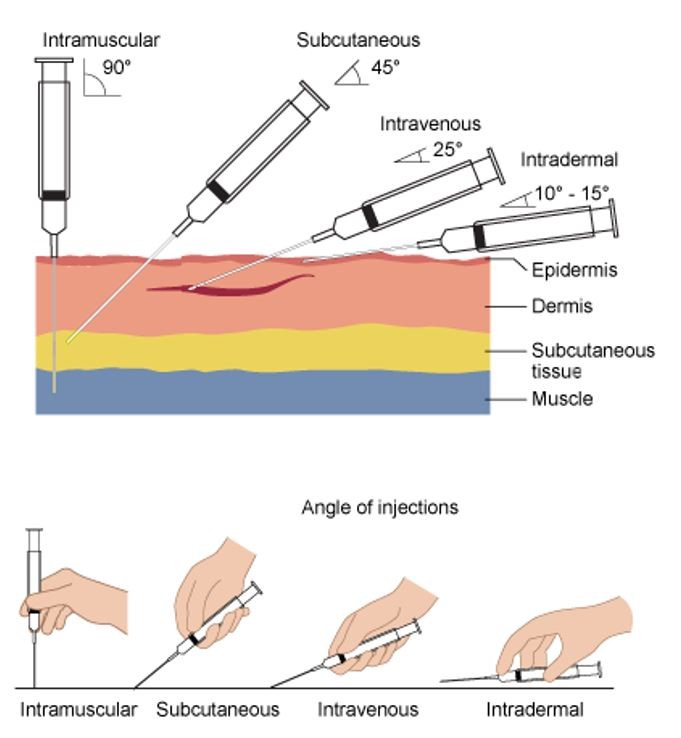How you Administer Injections Matters
Amy Barkley, Team Leader & Livestock Specialist
Southwest New York Dairy, Livestock and Field Crops Program
Injections are necessary, and sometimes even life-saving, for many of our livestock species. Each liquid that we inject is formulated to be placed not only in different regions of the body (think the triangular mass of muscle of the neck for most cattle vaccines vs the buttocks for some equine injections), but also in different layers of tissue (muscle vs skin vs vein). The correct placement of a needle allows the vaccine, fluid, or antibiotic to fall in the proper place to be absorbed by the body in the most effective manner. Angles of the four most common injections are listed below from largest (perpendicular with the skin surface) to smallest (nearly parallel with the skin surface).
Intramuscular: This injection is made to go deep into the muscle. The needle will be placed at a 90-degree angle (perpendicular) to the skin to allow for penetration into that tissue. A large muscle works best for these injections, but care needs to be taken with placement, especially on meat animals, since many of these injections cause damage, and ultimately condemnation, of the muscle tissue they come in contact with.
Subcutaneous: A properly placed subcutaneous injection is going to result in a lump of fluid underneath the two layers of skin (epidermis and dermis). The depth of these two layers varies with species, breed, and age. Under the skin layers resides connective tissues, which lack blood vessels, resulting in a slow absorption of any liquid placed there. An area of loose skin is an ideal place for these injections since there is room for the fluid to accumulate. The needle will be placed at an angle of 45 degrees to the skin surface.
Intravenous: The needles used for either injections or removal of blood should be placed where a vein is readily accessible. This is usually in the legs, neck, udder, or tailhead of our livestock species. Many times, the veins are readily visible, but sometimes moderate pressure needs to be applied below the area where blood is being removed to make the vein obvious. To access the vein, the needle should be inserted at an angle of 25 degrees to the skin. Drawing back on the plunger of a properly placed syringe should result in some blood in the syringe body, indicating the needle is in the vein.
Intradermal: This injection requires the needle to be placed just under the epidermis (outer layer of skin) and into the dermis (inner layer of skin). These injections take a very fine needle (larger gauge, shorter length). Correct placement of the needle is between 10 and 15 degrees with the skin surface. Correct placement is verified by the formation of a blister of fluid just under a thin layer of skin.
 Photo from Wikipedia
Photo from WikipediaUpcoming Events
Crops, Cows & Critters - Southwest New York Dairy, Livestock & Field Crops Newsletter Sponsorship
December 19, 2025
Our two forms of publications feature research-based and timely information from our four specialists, listed to the right, along with local event notifications and Cornell University outreach. This information is provided to participants who range from dairy, livestock, and field crops producers to agricultural suppliers and consultants.
Weekly Email Update: Shared with 625+ households who have signed up with our program.
Monthly Paper Mailer: To reach our stakeholders and farmers who lack internet access, we send out a monthly mailer where your company's logo and contact information would be featured with a mailing list of 330+ households.
If you sponsor our weekly and monthly publications you reach approximately 955 households.
Visit our website to view our newsletters!
2025 Cornell Food Beverage & Animal Feed Manufacturer Survey
December 19, 2025
Industry and Educational Advocates for New York State's Food, Beverage, and Animal Feed Manufacturing industries:
As you know, NYS has a diverse food and beverage manufacturing industry, in both the types of industries that exist and the wide distribution of firms by scale. Many manufacturing firms have strong backward linkages to agricultural production sectors in the state that support both farm-level and downstream food industry firms and consumers. In collaboration with the New York State Department of Agriculture and Markets, a team from Cornell University's Charles H. Dyson School of Applied Economics and Management has recently rolled out the 2025 New York State Food, Beverage, and Animal Feed Manufacturer Survey. The industry will benefit from an updated assessment of the industry that informs private and public investments and opportunities to support firm growth and improved profitability.
Boots in the Barn: Cornell Dairy Research Updates
January 13, 2026
January 20, 2026
January 27, 2026
February 3, 2026
February 10, 2026
February 17, 2026
February 24, 2026
Join us for some or all!
Announcements
No announcements at this time.





